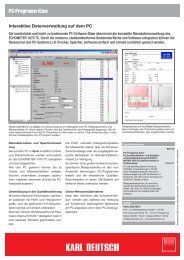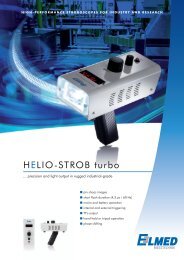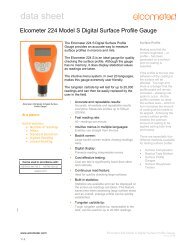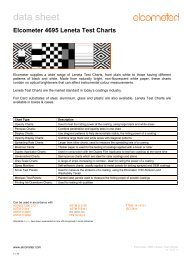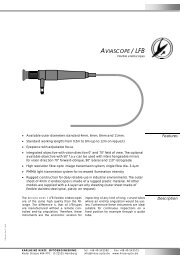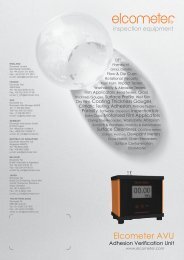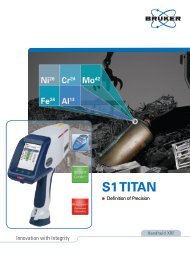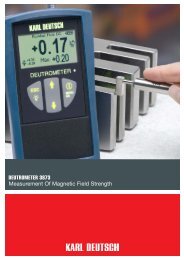KD-Check Penetrants Liquid Penetrant Testing - Karl Deutsch ...
KD-Check Penetrants Liquid Penetrant Testing - Karl Deutsch ...
KD-Check Penetrants Liquid Penetrant Testing - Karl Deutsch ...
You also want an ePaper? Increase the reach of your titles
YUMPU automatically turns print PDFs into web optimized ePapers that Google loves.
<strong>KD</strong>-<strong>Check</strong><br />
... if cracks shall be detected with liquid penetrants testing<br />
<strong>Liquid</strong> <strong>Penetrant</strong> <strong>Testing</strong> is a nondestructive testing (NDT) method, which enables the visualization of surface<br />
cracks if the defect is open to the surface. Inhomogenities in the volume cannot be detected.<br />
Mainly metals, but also plastics and ceramics can be inspected with liquid penetrant testing. It is recommended<br />
to execute a tolerance check on plastics before beginning the inspection.<br />
The method is very sensitive. Cracks or pores with typical widths between 0.5 µm and 10 µm and depths<br />
between 20 µm and 200 µm can be detected by means of the liquid penetrant testing method.<br />
Dye penetrant testing (red-white method)<br />
Dye penetrant<br />
Fluorescent penetrant<br />
Cleaner<br />
Cleaner<br />
Developer<br />
<strong>KD</strong>-<strong>Check</strong> agents in spray cans<br />
Red penetrants are often used because of the easy handling. Only one spray can of cleaner, penetrant<br />
and developer is required for inspection in each case. Therefore, the penetrant method is well suited for<br />
on-site inspections, in case of maintenance and for random tests. The evaluation is carried out in<br />
normal daylight.<br />
Fluorescent penetrant testing<br />
Due to higher sensitivities of fluorescent test liquids this method is mainly applied for the serial inspection<br />
of safety relevant objects, e.g. in the aerospace and automotive industry. By means of stationary testing<br />
systems a large number of objects can be tested reproducibly within a short time. The testing sensitivity is<br />
further increased by using dry developers which are applied electrostatically.<br />
Steps of liquid penetrant testing according to EN ISO 3452<br />
Crack indication obtained with<br />
the red-white method<br />
1. Crack filled with dirt<br />
2. Ideally cleaned<br />
3. <strong>Penetrant</strong> application<br />
4. <strong>Penetrant</strong> removal<br />
5. Developer application<br />
6. Crack indication<br />
Fluorescent penetrant according to<br />
EN ISO 3452 und AMS 2644<br />
<strong>KD</strong>-<strong>Check</strong> agents are…<br />
• free of CFC / CHC (do not contain any OLDS)<br />
• applicable considering the TRGS 614<br />
(Technical Rules for dangerous substances:<br />
Application limits for defined azo dyes)<br />
• manufactured according to EN ISO 9001<br />
• listed according to AREVA NP TLV 9017<br />
• are marked with ‘Low sulfur and halogen<br />
content according to EN ISO 3452’<br />
concerning corrosive components<br />
(sulfur, fluorine and chlorine),<br />
and complies with the requirements of<br />
ASME-Code Section V, Article 6<br />
Extensive Documentation*<br />
* Material Safety Data Sheets and Technical Informations can be downloaded from<br />
www.karldeutsch.de » Downloads » Chemical Products




